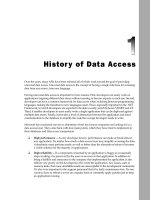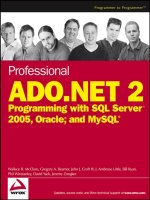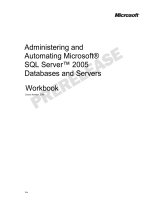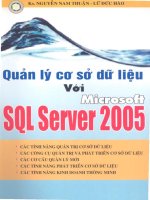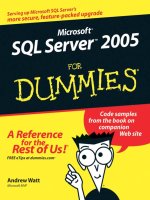- Trang chủ >>
- Đại cương >>
- Kinh tế vĩ mô
mcts microsoft sql server 2005 implementation and maintenance study guide
Bạn đang xem bản rút gọn của tài liệu. Xem và tải ngay bản đầy đủ của tài liệu tại đây (19.42 MB, 679 trang )
Wiley Publishing, Inc.
MCTS
®
Microsoft
™
SQL Server 2005
Implementation and Maintenance
Study Guide
(Exam 70-431)
Joseph L. Jorden
Dandy Weyn
25654ffirs.fm Page iii Tuesday, June 13, 2006 1:21 AM
25654ffirs.fm Page ii Tuesday, June 13, 2006 1:21 AM
MCTS
®
Microsoft
™
SQL Server 2005
Implementation and Maintenance
Study Guide
(Exam 70–431)
25654ffirs.fm Page i Tuesday, June 13, 2006 1:21 AM
25654ffirs.fm Page ii Tuesday, June 13, 2006 1:21 AM
Wiley Publishing, Inc.
MCTS
®
Microsoft
™
SQL Server 2005
Implementation and Maintenance
Study Guide
(Exam 70-431)
Joseph L. Jorden
Dandy Weyn
25654ffirs.fm Page iii Tuesday, June 13, 2006 1:21 AM
Acquisitions and Development Editor: Maureen Adams
Technical Editors: Marcellus Duffy and Marilyn Miller-White
Production Editor: Daria Meoli
Copy Editor: Kim Wimpsett
Production Manager: Tim Tate
Vice President and Executive Group Publisher: Richard Swadley
Vice President and Executive Publisher: Joseph B. Wikert
Vice President and Publisher: Neil Edde
Permissions Editor: Shannon Walters
Media Development Specialist: Steven Kurdirka
Book Designer: Judy Fung
Compositor and Illustrator: Jeffrey Wilson, Happenstance Type-O-Rama
Proofreader: Nancy Riddiough
Indexer: Ted Laux
Cover Designer: Archer Design
Copyright © 2006 by Wiley Publishing, Inc., Indianapolis, Indiana
Published by Wiley Publishing, Inc., Indianapolis, Indiana
Published simultaneously in Canada
ISBN-13: 978-0-470-02565-9
ISBN-10: 0-470-02565-4
No part of this publication may be reproduced, stored in a retrieval system or transmitted in any form or by any
means, electronic, mechanical, photocopying, recording, scanning or otherwise, except as permitted under Sec-
tions 107 or 108 of the 1976 United States Copyright Act, without either the prior written permission of the Pub-
lisher, or authorization through payment of the appropriate per-copy fee to the Copyright Clearance Center, 222
Rosewood Drive, Danvers, MA 01923, (978) 750-8400, fax (978) 646-8600. Requests to the Publisher for per-
mission should be addressed to the Legal Department, Wiley Publishing, Inc., 10475 Crosspoint Blvd., Indianap-
olis, IN 46256, (317) 572-3447, fax (317) 572-4355, or online at />Limit of Liability/Disclaimer of Warranty: The publisher and the author make no representations or warranties
with respect to the accuracy or completeness of the contents of this work and specifically disclaim all warranties,
including without limitation warranties of fitness for a particular purpose. No warranty may be created or
extended by sales or promotional materials. The advice and strategies contained herein may not be suitable for
every situation. This work is sold with the understanding that the publisher is not engaged in rendering legal,
accounting, or other professional services. If professional assistance is required, the services of a competent pro-
fessional person should be sought. Neither the publisher nor the author shall be liable for damages arising here-
from. The fact that an organization or Website is referred to in this work as a citation and/or a potential source
of further information does not mean that the author or the publisher endorses the information the organization
or Website may provide or recommendations it may make. Further, readers should be aware that Internet Web-
sites listed in this work may have changed or disappeared between when this work was written and when it is read.
For general information on our other products and services or to obtain technical support, please contact our Customer
Care Department within the U.S. at (800) 762-2974, outside the U.S. at (317) 572-3993 or fax (317) 572-4002.
Wiley also publishes its books in a variety of electronic formats. Some content that appears in print may not be
available in electronic books.
Library of Congress Cataloging-in-Publication Data is available from the publisher.
TRADEMARKS: Wiley, the Wiley logo, and the Sybex logo are trademarks or registered trademarks of John
Wiley & Sons, Inc. and/or its affiliates, in the United States and other countries, and may not be used without
written permission. Microsoft and SQL Server are trademarks or registered trademarks of Microsoft Corpora-
tion in the United State and /or other countries.All other trademarks are the property of their respective owners.
Wiley Publishing, Inc., is not associated with any product or vendor mentioned in this book.
10 9 8 7 6 5 4 3 2 1
25654ffirs.fm Page iv Tuesday, June 13, 2006 1:21 AM
To Our Valued Readers:
Thank you for looking to Sybex for your Microsoft SQL Server 2005 certification exam prep
needs. The Sybex team at Wiley is proud of its reputation for providing certification candi-
dates with the practical knowledge and skills needed to succeed in the highly competitive IT
workplace. Just as Microsoft Learning is committed to establishing measurable standards
for certifying individuals who design and maintain SQL Server 2005 systems, Sybex is com-
mitted to providing those individuals with the skills needed to meet those standards.
The authors and editors have worked hard to ensure that the Study Guide you hold in your
hands is comprehensive, in-depth, and pedagogically sound. We’re confident that this book
will exceed the demanding standards of the certification marketplace and help you, the SQL
Server 2005 certification candidate, succeed in your endeavors.
As always, your feedback is important to us. If you believe you’ve identified an error in the
book, please visit the Customer Support section of the Wiley web site. Or if you have general
comments or suggestions, feel free to drop me a line directly at At Sybex
we’re continually striving to meet the needs of individuals preparing for certification exams.
Good luck in pursuit of your SQL Server 2005 certification!
Neil Edde
Vice President & Publisher
Sybex, an Imprint of John Wiley & Sons
25654ffirs.fm Page v Tuesday, June 13, 2006 1:21 AM
For my wife, Rachelle
—Joseph L. Jorden
For my little cousin Gunnar and all other kids with muscular dystrophy
—Dandy Weyn
25654ffirs.fm Page vi Tuesday, June 13, 2006 1:21 AM
Acknowledgments
Like all the books I’ve written and tech edited for Sybex over the years, this has been quite a
ride. A lot of work goes into these books, and it is not all from the authors. When it comes time
for accolades, the first person who comes to mind is our acquisitions editor, Maureen Adams.
She got the ball rolling and kept it rolling the whole time. I would also like to thank the pro-
duction editor, Daria Meoli; the copy editor, Kim Wimpsett; and the tech editors, Marcellus
Duffy and Marilyn Miller-White for all their hard work in making the book a success.
I owe my friends and family a special thanks because they supported me throughout my
writing odyssey even though they didn’t quite understand what it was that I was writing about.
First, my family: Mary (a.k.a. Mom); Buddy and Shelly Jorden; and Janet, Colin, and Leian
McBroom—thanks to all of you. Also, when I started to lose my sanity, there were those who
helped me look for it (we’ll find it yet!): I have to thank Zerick Campbell (Big Daddy Z); his
lovely and talented wife, Tanya; and the boys, Jostin and Brenton. Thanks to everyone at Jelly
Belly; there is no better place to work than a candy company. For all the laughs I have to thank
Nick Saechow—you rock (insert noun here)! Special thanks to Jyles McDonald for working
with me all those early mornings; let’s do it again sometime. Most important, though, thanks
to my wife, Rachelle Jorden, for her patience and understanding as I wrote yet another book.
Finally, thanks to all of you for reading this work. May it serve you well. —Joseph L. Jorden
From my part, I want to thank Joseph L. Jorden for his dedication and support as an expe-
rienced writer. I would not have been able to complete this work without the support of our
acquisitions editor, Maureen Adams. Thanks, Maureen—you had so much patience with me.
A special thanks goes to Cristian Lefter, who supplied a lot of questions and additional tech
review for this book; I am really looking forward to writing a book together one day.
Thanks also to all my friends for their support, and please let’s not forget my mom and stepdad!
Unfortunately, I spent a lot of time writing instead of playing tour guide on their first U.S. visit.
A special thanks to my special friend and fellow MCT Paul Silva. Thanks, Paul, for taking
care, for being concerned when I got stressed, and for being such a close friend. Also, thanks to
the entire Microsoft Certified Trainer community, who gave me the opportunity to train on SQL
Server 2005 and harden my skills on the product by all the interesting questions they devised.
And thanks to all of you reading this, and congratulations on your interest in becoming
a Microsoft Certified Technology Specialist on SQL Server 2005. Finally, a big thank you
to the Microsoft SQL Server product team members who made this product so successful
and built all these cool features. —Dandy Weyn
25654ffirs.fm Page vii Tuesday, June 13, 2006 1:21 AM
25654ffirs.fm Page viii Tuesday, June 13, 2006 1:21 AM
About the Authors
Joseph L. Jorden
(MCP, MCSE, MCTS) is the Lead Developer for Jelly Belly Candy Company
where he spends a great deal of his time developing database applications and assisting the
DBA with SQL Server administration tasks. Joseph was one of the first 100 people to achieve
the MCSE+I certification from Microsoft and one of the first 2,000 people to earn the MCSE
certification on Windows 2000. Joseph also spent a few years as an MCT during which time
he taught Microsoft Official Curriculum courses on SQL Server 6.5, 7.0, and 2000. He has
spoken at PASS conferences and Comdex about SQL Server and computing subjects. Joseph
has also written a number of articles for various publications, and he has written and tech
edited several books for Sybex, most of them on the subject of SQL Server.
Dandy Weyn
is a SQL Server technologist, born and raised in Belgium, Europe. He started
working with databases by the age of 16, when he sold his first commercial database applica-
tion on dBASE III. He worked with various non-Microsoft relational databases before he
switched to SQL Server 6.5. Dandy has more than 10 years’ experience in relational database
design and training. He started his own company in 2000 and has been trained using all
Microsoft Official Curriculum targeting Microsoft certification since NT 4.0.
Although he is based in Belgium, Dandy spends most of his time in the United States, where
the past couple of years he trained in the Microsoft Partner Readiness Channel and delivered
workshops and seminars all over the country. In 2005 Dandy trained more than 1,000 people
on SQL Server and has been to more than 30 cities in North America to broadcast his passion
for SQL Server 2005.
For his early training on SQL Server 2005 in the MCT community, by organizing Train the
Trainer events, he was awarded with a Microsoft Certified Trainer Community Leader title.
For the past couple of years Dandy was also part of the team that structures and organizes the
hands-on labs at premier conferences as Microsoft Tech-Ed. In 2005 he presented instructor-
led hands-on labs at the Microsoft World Wide Partner Conference, and he developed
courseware for the Microsoft Partner Readiness Channel. In 2006 Dandy delivered seminars
for Microsoft Kenya and Microsoft Portugal and again provided his knowledge as Technical
Learning Guide at Microsoft Tech-Ed. Besides being current with the new SQL Server 2005
certification, he also has MCSA, MCDBA, MCDST, and MCSE certifications. Dandy is a fre-
quent poster in database forums and is also founder of a new SQL Server community site
(
www.ilikesql.com
).
25654ffirs.fm Page ix Tuesday, June 13, 2006 1:21 AM
25654ffirs.fm Page x Tuesday, June 13, 2006 1:21 AM
Contents at a Glance
Introduction xxi
Assessment Test xxviii
Chapter 1
Installing Microsoft SQL Server 2005 1
Chapter 2
Creating and Configuring Databases 31
Chapter 3
Working with Tables and Views 61
Chapter 4
Performing Indexing and Full-Text Searching 107
Chapter 5
Introducing More Database Objects 141
Chapter 6
Implementing Security in SQL Server 2005 189
Chapter 7
Working with Relational Data 241
Chapter 8
Working with XML Data 281
Chapter 9
Working with Service Broker and HTTP 311
Chapter 10
Maintaining and Automating SQL Server 347
Chapter 11
Performing Backups and Restores 415
Chapter 12
Achieving High Availability through Replication 463
Chapter 13
Introducing More High-Availability Methods 521
Chapter 14
Monitoring and Optimizing SQL Server 2005 557
Glossary
595
Index 609
25654ffirs.fm Page xi Tuesday, June 13, 2006 1:21 AM
25654ffirs.fm Page xii Tuesday, June 13, 2006 1:21 AM
Contents
xiii
Contents
Introduction xxi
Assessment Test xxviii
Chapter 1 Installing Microsoft SQL Server 2005 1
Meeting the Prerequisites 2
Preparing to Install 5
Choosing Default Instances or Named Instances 5
Choosing Service Accounts 6
Selecting an Authentication Mode 6
Choosing a Collation Setting 7
Upgrading from a Previous Version 8
Installing SQL Server 2005 10
Installing a Second Instance 19
Troubleshooting the Installation 22
Summary 23
Exam Essentials 23
Review Questions 24
Answers to Review Questions 28
Chapter 2 Creating and Configuring Databases 31
Planning Your Database 32
Introducing Database Files 32
Introducing Filegroups 33
Deciding on Database File Placement 34
Introducing RAID-0 35
Introducing RAID-1 35
Introducing RAID-5 35
Introducing RAID-10 35
Creating Data Storage Structures 36
Introducing Extents 36
Introducing Pages 37
Estimating Storage Requirements 38
Estimating Table Storage Requirements 38
Estimating Index Storage Requirements 41
Creating and Configuring Databases 42
Creating a Database 42
Gathering Information about Your Database 44
Setting Database Options 46
Summary 50
Exam Essentials 51
Review Questions 52
Answers to Review Questions 59
25654ftoc.fm Page xiii Tuesday, June 13, 2006 1:35 AM
xiv
Contents
Chapter 3 Working with Tables and Views 61
Planning Tables 62
Introducing Built-in Datatypes 63
Introducing Computed Columns 66
Creating Tables 67
Restricting the Data 72
Introducing Constraints 73
Partitioning Tables 80
Understanding Views 82
Modifying Data through a View 84
Working with Indexed Views 88
Summary 93
Exam Essentials 94
Review Questions 96
Answers to Review Questions 105
Chapter 4 Performing Indexing and Full-Text Searching 107
Understanding Index Architecture 108
Understanding Heaps 109
Understanding Clustered Indexes 111
Understanding Nonclustered Indexes 116
Creating Indexes 122
Using Primary Keys 123
Using Full-Text Searching 126
Summary 133
Exam Essentials 133
Review Questions 134
Answers to Review Questions 139
Chapter 5 Introducing More Database Objects 141
Introducing Stored Procedures 142
Understanding the Types of Stored Procedures 142
Creating Stored Procedures 145
Recompiling Stored Procedures 149
Introducing Triggers 150
Understanding the Types of Triggers 150
Understanding DML Triggers 151
Understanding DDL Triggers 154
Understanding Trigger Recursion and Nesting 158
Understanding Disabling Triggers 159
Understanding Event Notifications 159
Introducing Functions 166
Understanding the Types of Functions 166
Using Scalar Functions 166
25654ftoc.fm Page xiv Tuesday, June 13, 2006 1:35 AM
Contents
xv
Introducing Table-Valued Functions 167
Introducing Built-in Functions 167
Introducing CLR Functions 169
Introducing Deterministic and Nondeterministic
Functions 171
Introducing User-Defined Types 172
Creating T-SQL User-Defined Types 172
Creating CLR User-Defined Types 173
Getting More CLR Functionality 174
Summary 175
Exam Essentials 175
Review Questions 176
Answers to Review Questions 185
Chapter 6 Implementing Security in SQL Server 2005 189
Understanding Security Modes 190
Using Windows Authentication Mode 190
Using Mixed Mode 191
Setting the Authentication Mode 191
Understanding SQL Server Logins 193
Using Standard Logins 193
Using Windows Logins 196
Understanding the Items Common to All Logins 199
Understanding Fixed Server Roles 199
Creating Database User Accounts 202
Understanding Permissions 204
Applying Statement Permissions 205
Applying Object Permissions 207
Understanding Database Roles 210
Using Fixed Database Roles 210
Using Custom Database Roles 212
Using Application Roles 215
Understanding Permission States 217
Granting a Permission 217
Revoking a Permission 217
Denying a Permission 217
Introducing Ownership Chains 221
Introducing Linked Server Security 223
Introducing Encryption 224
Creating a Security Plan 225
Summary 227
Exam Essentials 229
Review Questions 230
Answers to Review Questions 238
25654ftoc.fm Page xv Tuesday, June 13, 2006 1:35 AM
xvi
Contents
Chapter 7 Working with Relational Data 241
Understanding and Using Transactions 242
Executing Implicit and Explicit Transactions 243
Committing and Rolling Back 244
Executing Distributed Transactions 246
Populating Tables 247
Importing Data Using Bulk Insert 247
Importing Data Using the
bcp
Utility 248
Copying Data Using SSIS 250
Bulk Inserting XML Data 252
Supporting the Bulk-Logged Recovery Model 253
Supporting Different Collation Types and Orders
When Querying Data 255
Formatting and Converting Datatypes 256
Casting and Converting 261
Understanding Datatype Precedence 264
Understanding Collations 265
Introducing Error Handling 266
Using
RAISERROR
266
Using
@@ERROR
267
Using Error Messages 267
Using
TRY…CATCH
Blocks 268
Summary 272
Exam Essentials 272
Review Questions 274
Answers to Review Questions 278
Chapter 8 Working with XML Data 281
Understanding XML Data 282
Using the xml Datatype 283
Using Untyped XML 284
Using Typed XML 285
Working with XML Schema 285
Querying XML Data 288
Using the
query
Method 288
Using the
value
Method 289
Using the
exist
Method 290
Using the
modify
Method 290
Using the
nodes
Method 291
Creating XML Indexes 295
Summary 297
Exam Essentials 297
Review Questions 298
Answers to Review Questions 308
25654ftoc.fm Page xvi Tuesday, June 13, 2006 1:35 AM
Contents
xvii
Chapter 9 Working with Service Broker and HTTP 311
Understanding the SQL Server Service Broker Architecture 312
Working with Service Broker 313
Creating a Message Type 313
Creating a Queue 314
Creating a Contract 315
Creating a Service 316
Creating a Route 317
Using Service Broker 318
Sending Messages 318
Receiving Messages 321
Automating the Queue Processing 323
Introducing HTTP Endpoints 328
Configuring HTTP Endpoints 329
Securing HTTP Endpoints 334
Summary 334
Exam Essentials 336
Review Questions 337
Answers to Review Questions 345
Chapter 10 Maintaining and Automating SQL Server 347
Maintaining Indexes 348
Understanding
sys.DM_DB_INDEX_PHYSICAL_STATS
349
Reorganizing and Rebuilding Indexes 352
Maintaining Statistics 354
Maintaining Databases 355
Understanding
DBCC CHECKDB
355
Shrinking Files 357
Understanding Automation Basics 359
Configuring Database Mail 361
Creating Operators 366
Creating Jobs 369
Creating Alerts 376
Creating Event Alerts Based on Standard Errors 377
Creating Event Alerts Based on Custom Errors 382
Creating Performance Alerts 385
Creating WMI Alerts 387
Using the Maintenance Plan Wizard 389
Copying Databases 399
Summary 405
Exam Essentials 406
Review Questions 407
Answers to Review Questions 413
25654ftoc.fm Page xvii Tuesday, June 13, 2006 1:35 AM
xviii
Contents
Chapter 11 Performing Backups and Restores 415
Backing Up Your Data 416
Understanding How Backups Work 417
Creating a Backup Device 418
Performing Full Backups 419
Performing Differential Backups 423
Performing Transaction Log Backups 426
Performing Filegroup Backups 428
Backing Up to Multiple Devices 434
Restoring Databases 438
Performing Standard Restores 439
Performing Point-in-Time Restores 443
Performing Piecemeal Restores 446
Devising a Backup Strategy 448
Planning for Full Backups Only 448
Planning for Full with Differential Backups 449
Planning for Full with Transaction Log Backups 450
Planning for Full, Differential, and Transaction
Log Backups 451
Planning for Filegroup Backups 451
Summary 452
Exam Essentials 453
Review Questions 454
Answers to Review Questions 460
Chapter 12 Achieving High Availability through Replication 463
Introducing Replication 464
Introducing the Publisher/Subscriber Metaphor 465
Introducing Articles 466
Introducing Publications 467
Understanding Replication Factors
and Distribution Types 467
Using Distributed Transactions 468
Using Transactional Replication 469
Using Transactional Replication with Immediate
Updating Subscribers 469
Using Snapshot Replication 470
Using Snapshot Replication with Immediate
Updating Subscribers 470
Using Merge Replication 470
Using Queued Updating 471
Understanding Replication Internals 472
Understanding Merge Replication 473
25654ftoc.fm Page xviii Tuesday, June 13, 2006 1:35 AM
Contents
xix
Understanding Snapshot Replication 476
Understanding Transactional Replication 476
Considering Publication Issues 478
Considering Distributor Issues 479
Introducing Replication Models 480
Introducing Central Publisher/Central Distributor 480
Introducing Remote Distribution 481
Introducing Central Subscriber/Multiple Publishers 482
Introducing Multiple Publishers/Multiple Subscribers 483
Replicating over the Internet and to Heterogeneous
Database Servers 484
Using Heterogeneous Replication 484
Using Internet Replication 484
Installing and Using Replication 485
Configuring SQL Server for Replication 485
Installing a Distribution Server 486
Adding a Publication 490
Creating a Subscription 496
Testing Replication 502
Managing Replication 503
Considering Administrative Issues 504
Considering Replication Backup Issues 504
Using the Replication Monitor 505
Working with Replication Scripts 508
Enhancing Replication Performance 509
Summary 511
Exam Essentials 512
Review Questions 513
Answers to Review Questions 519
Chapter 13 Introducing More High-Availability Methods 521
Choosing the High-Availability
Features You Need 522
Implementing Database Mirroring 523
Understanding Database Mirroring Concepts 524
Preparing for Mirroring 525
Creating Endpoints 526
Specifying Partners and Witnesses 529
Configuring the Operating Mode 530
Switching Roles 531
Implementing Log Shipping 532
Monitoring the Server 533
Configuring Log Shipping 533
Changing Roles 538
Monitoring Log Shipping 538
25654ftoc.fm Page xix Tuesday, June 13, 2006 1:35 AM
xx
Contents
Managing Database Snapshots 539
Creating a Snapshot 540
Reverting from a Snapshot 543
Summary 547
Exam Essentials 548
Review Questions 549
Answers to Review Questions 555
Chapter 14 Monitoring and Optimizing SQL Server 2005 557
Using System Monitor 559
Monitoring with SQL Profiler 565
Replaying a Trace File 570
Using the Database Engine Tuning Advisor 572
Troubleshooting SQL Server 576
Reading Error and Event Logs 577
Troubleshooting Blocks and Deadlocks 579
Troubleshooting Jobs 582
Using the Dedicated Administrator Connection 583
Summary 585
Exam Essentials 587
Review Questions 588
Answers to Review Questions 593
Glossary
595
Index 609
25654ftoc.fm Page xx Tuesday, June 13, 2006 1:35 AM
Introduction
Microsoft’s new generation of certifications emphasizes not only your proficiency with a
specific technology but also tests whether you have the skills needed to perform a specific
role. The Microsoft Certified Technology Specialist: SQL Server 2005 exam tests whether
you know how to use SQL Server 2005 not only in theory but in practice. This makes the
Microsoft Certified Technology Specialist: SQL Server 2005 certification a powerful cre-
dential for career advancement.
Obtaining this certificate has only one exam requirement, 70-431TS: Microsoft SQL Server
2005—Implementation and Maintenance. We developed this book primarily to give you the
information you need to prepare for this exam. But don’t put the book away after you pass;
it will serve as a valuable reference during your career as a SQL Server 2005 professional.
Introducing the Microsoft Certified Technology
Specialist Program
Since the inception of its certification program, Microsoft has certified millions of people. Over
the years, Microsoft has learned what it takes to help people show their skills through certifica-
tion. Based on that experience, Microsoft has introduced a new generation of certifications:
Microsoft Certified Technology Specialist (MCTS)
Microsoft Certified IT Professional (MCITP)
Microsoft Certified Professional Developer (MCPD)
Microsoft Certified Architect (MCA)
The MCTS certification program is designed to validate core technology and product skills
for a specific product. It helps you prove you are capable of implementing, building, trouble-
shooting, and debugging that product.
The new generation of exams offers a shorter certification path than previous iterations.
For example, to become a Microsoft Certified Database Administrator, you have to pass four
exams. To obtain an MCTS certification, you need to pass only one exam.
How Do You Become Certified on SQL Server 2005?
As mentioned, you have to pass only one test to gain certification, but attaining a Microsoft cer-
tification has always been a challenge. In the past, students have been able to acquire detailed
exam information—even most of the exam questions—from online “brain dumps” and third-
party “cram” books or software products. This is no longer the case.
To ensure that a Microsoft certification really means something, Microsoft has taken
strong steps to protect the security and integrity of its certification tracks. Now prospective
candidates must complete a course of study that develops detailed knowledge about a wide
range of topics. It supplies them with the true skills needed, derived from working with SQL
Server 2005.
25654flast.fm Page xxi Tuesday, June 13, 2006 1:34 AM
xxii
Introduction
The SQL Server 2005 certification programs are heavily weighted toward hands-on skills
and experience. Microsoft has stated that “nearly half of the core required exams’ content
demands that the candidate have troubleshooting skills acquired through hands-on experience
and working knowledge.”
Fortunately, if you are willing to dedicate the time and effort to learn SQL Server 2005, you
can prepare yourself well for the exams by using the proper tools. By working through this
book, you can successfully meet the exam requirements to pass the SQL Server 2005—Imple-
mentation and Maintenance exam.
This book is part of a complete series of study guides published by Sybex, an imprint of Wiley.
Please visit the Sybex website at
www.sybex.com
and the Wiley website at
www.wiley.com
for
complete program and product details.
Registering for the Exam
You may take the Microsoft exams at any of more than 1,000 Authorized Prometric Testing
Centers (APTCs) and VUE testing centers around the world. For the location of a testing center
near you, call Prometric at 800-755-EXAM (755-3926), or call VUE at 888-837-8616. Outside
the United States and Canada, contact your local Prometric or VUE registration center.
Find out the number of the exam you want to take (70-431 for the SQL Server 2005—
Implementation and Maintenance exam), and then register with Prometric or VUE. At this
point, you will be asked for advance payment for the exam. The exams vary in price depending
on the country in which you take them. You can schedule exams up to six weeks in advance
or as late as one working day prior to the date of the exam. You can cancel or reschedule your
exam if you contact the center at least two working days prior to the exam. Same-day regis-
tration is available in some locations, subject to space availability. Where same-day registra-
tion is available, you must register a minimum of two hours before test time.
You may also register for your exams online at
www.prometric.com
or
www.vue.com
.
When you schedule the exam, you will be provided with instructions regarding appointment
and cancellation procedures, information about ID requirements, and information about the
testing center location. In addition, you will receive a registration and payment confirmation
letter from Prometric or VUE.
Microsoft requires certification candidates to accept the terms of a nondisclosure agree-
ment before taking certification exams.
Taking the SQL Server 2005—Implementation and Maintenance Exam
The SQL Server 2005—Implementation and Maintenance exam covers concepts and skills
related to implementing and managing SQL Server 2005. It emphasizes the following elements
of server management:
Installing and configuring SQL Server 2005
Implementing high availability and disaster recovery
25654flast.fm Page xxii Tuesday, June 13, 2006 1:34 AM

